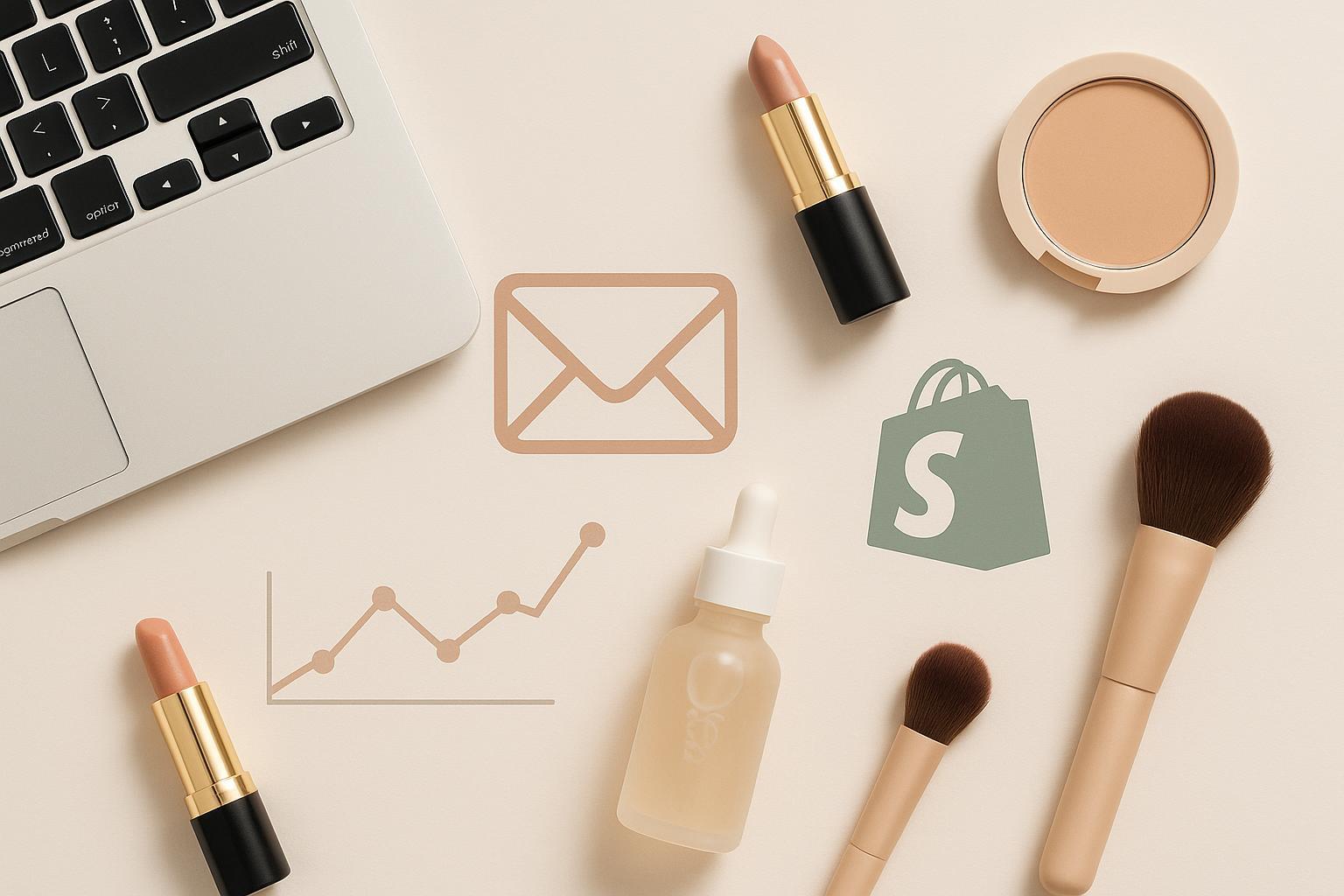Top Email Marketing Tips for Shopify Beauty Startups

Launching a beauty brand on Shopify means juggling product launches, UGC, and retention—often with a tiny team. This field-tested guide shows exactly how to set up, optimize, and measure email so it reliably drives first and repeat purchases without bloating your workflow.
What “good” looks like for beauty email in 2025
- Treat open rate as directional only post-MPP. For context, Klaviyo’s 2025 Health & Beauty snapshot reports a 35.9% open rate; focus your goals on clicks, placed order rate, and revenue per recipient rather than opens, per the guidance in the Klaviyo 2025 email benchmarks by industry.
- For planning volume and pacing, Shopify recommends starting with a few essential automations—welcome, abandoned checkout, and back-in-stock—then expanding to behavior-triggered flows as you grow; see the 2025 overview on Shopify’s automated email campaigns that win customers.
Pro tip: Judge campaigns by placed order rate and revenue per recipient (RPR). Set weekly “program health” checks on unsubscribe and complaint rates alongside conversion.
Build your list the right way (beauty-specific and compliant)
Summary: Grow an engaged list using value-led popups and post-purchase opt-ins. Protect deliverability with clean consent and sender authentication.
How to implement fast:
- Offer a relevant value exchange. Examples: “Find your perfect shade” quiz results, “Start your acne-care routine” guide, or a modest first-order perk. Use a two-step popup: teaser card → email capture → optional SMS.
- Use double opt-in to keep quality high and reduce bounces. Shopify’s guidance on list building emphasizes quality over quantity; see the 2025 article on how to build an email list that drives sales.
- Add post-purchase opt-ins on the order status page and within transactional emails for customers who skipped the popup.
- Authenticate your domain (SPF/DKIM/DMARC) and aim to keep spam complaint rates under 0.3% to satisfy mailbox provider rules introduced in 2024; this threshold and requirements are summarized in CloudKettle’s explainer of Gmail/Yahoo bulk-sender rules (2024).
Pitfall to avoid: Over-discounting at signup trains subscribers to wait for promos. Test non-discount value (regimen guides, quizzes, early access).
Segmentation that compounds (without over-fragmenting)
Summary: Start with engagement and purchase behavior. Layer in beauty-specific traits (routine stage, shade family, hair type) only where they change the message or offer.
Starter segments to set up:
- Engagement tiers: Active (clicked in 30 days), Warm (clicked 31–90), At-risk (no click 90+). Adjust cadence accordingly.
- Lifecycle: First-time purchasers vs. repeat buyers; VIPs (≥3 orders or top 10% LTV).
- Category and concern: Skincare (acne, hydration), Haircare (curl care, color-safe), Makeup (complexion vs. eyes). Use past purchases or quiz outcomes.
How to build quickly:
- In your ESP, create segments for “Purchased category X in last 120 days,” “No purchase in 60 days,” and “Clicked product education in last 30 days.” For deeper Shopify/Klaviyo stacks, connect your tools via the Attribuly Integrations List to centralize events before you expand segmentation logic.
Pro tip: If a segment holds fewer than ~2,000 subscribers for a weekly send, assess whether the lift from hyper-targeting beats the cost of creative/ops overhead.
Design for beauty inbox moments
Summary: Beauty audiences love visuals, but images alone won’t sell. Balance mobile-first design with scannable copy, education, and social proof.
Try this blueprint:
- Above the fold: Clear value statement (benefit-first), single primary CTA.
- Visuals: One hero image, 1–3 product or UGC tiles, and a quick tip or how-to block.
- Accessibility: 16px+ body text, high contrast CTAs, meaningful alt text.
- Load time: Compress images; avoid heavy GIFs.
Test ideas: Single offer vs. “routine builder” layout; placing a short tutorial before products; UGC snippet vs. star-rating bar. For QA across clients/devices, see recommendations in the Litmus ecommerce email guide (2025).
Lifecycle flows that do the heavy lifting
Set up these seven flows first. Each includes trigger, timing, and messaging outline with beauty-specific angles.
- Welcome series (3–4 emails)
- Trigger: Sign-up (exclude recent purchasers within 24–48h).
- Timing: Immediately, +2 days, +5–7 days.
- Content: Brand story and promise → quiz or regimen builder → bestsellers with social proof → gentle incentive.
- KPI: Signup-to-first order rate; RPR.
- Abandoned checkout/cart (2–3 emails)
- Trigger: Started checkout or added to cart, no purchase.
- Timing: 1 hour, 24 hours, 48 hours.
- Content: Reminder with image; objection handling (shade match, ingredients, returns); final nudge.
- KPI: Recovery rate; RPR.
- Browse abandonment (1–2 emails)
- Trigger: Viewed product, no add-to-cart.
- Timing: 6–24 hours.
- Content: Recently viewed items; ingredient spotlight; “still deciding?” with routine pairing.
- KPI: Click-to-cart; placed order rate.
- Post-purchase education and cross-sell (3 emails)
- Trigger: Order placed → fulfilled.
- Timing: +2 days (care/how-to), +7–10 days (regimen partner), +21–28 days (UGC/review request).
- Content: Application tips; pairings (e.g., cleanser → serum → moisturizer); ask for review with clear, compliant request.
- KPI: Review rate; cross-sell rate; repeat purchase time.
- Replenishment (1–2 emails per product category)
- Trigger: Consumable product near expected depletion.
- Timing guidance: Start with cohorts—skincare 45–90 days, haircare 60–120, makeup 90–180—then refine by your order history. Use A/B timing offsets (e.g., -7d vs. -3d before expected repurchase) to find the win.
- Content: “Running low?” with image; bundle or subscription option; quick reorder.
- KPI: Reorder rate; time-to-repurchase.
- Winback (1–2 emails)
- Trigger: No purchase in 60–90 days (tune per category cadence).
- Timing: Day 60/90, then +7 days.
- Content: What’s new; bestsellers resurfaced; incentive test for at-risk only.
- KPI: Reactivation rate; margin impact.
- VIP/loyalty
- Trigger: ≥3 orders, top 10% spenders, or NPS promoters.
- Timing: Monthly or tied to launches.
- Content: Early access; exclusive bundles; insider education.
- KPI: VIP share of revenue; retention.
For a concise overview of why these flows work and templates to start, review Klaviyo’s 2025 list of top ecommerce automations and Shopify’s 2025 automation overview linked earlier.
Beauty-only flows that boost relevance
- Quiz/shade finder follow-up: Send personalized routines or shade-specific content. Gate detailed quiz results behind email capture to increase opt-ins. Avoid hard claims about conversion lifts—test it in your store and track RPR.
- Restock/new shade drops: Notify “shade family” segments and waitlisted subscribers; add an SMS mirror for urgency.
- UGC collection: Ask customers 21–28 days post-delivery to share transformation photos; feature compliant UGC blocks in future emails.
- Influencer launch bursts: Seed to VIPs first; then broader segments with social proof. Ensure proper endorsement disclosures.
A tiny team’s A/B testing plan (that actually fits)
Run one test at a time per flow or campaign, measured on placed order rate and RPR.
Priority tests:
- Subject line patterns (benefit-first vs. curiosity; emoji vs. none). General overviews show that personalization and clarity often win, but effects vary by list; see the 2025 Bloomreach primer on email A/B testing for test structures.
- Send time/day (ESP send-time optimization vs. fixed windows) by segment.
- Offer framing (% off vs. $ off vs. free shipping threshold).
- Content block order (tutorial before products vs. after; UGC presence vs. none).
- CTA density (single primary vs. multiple secondary).
Stop criteria: Run at least one full buying cycle (e.g., 7–14 days) or until you hit statistically directional confidence for placed order rate.
Compliance, deliverability, and trust—checklist
Follow these non-negotiables to avoid costly inbox and legal issues.
- CAN-SPAM (United States): Accurate “From,” truthful subject lines, identify ads, include a physical address, provide a clear unsubscribe and honor opt-outs within 10 business days. The FTC’s official guide was updated in 2025: see the FTC CAN-SPAM compliance guide for businesses.
- GDPR (EU): Obtain explicit, informed consent (no pre-checked boxes), state purposes clearly, allow easy withdrawal, and maintain consent records; see the European Commission’s overview of EU data protection rules (GDPR).
- Influencer/UGC in emails: Disclose material connections clearly and near the endorsement; see the FTC’s Endorsement Guides FAQ.
- Deliverability: Authenticate with SPF/DKIM/DMARC; monitor complaint rate under 0.3% (Gmail/Yahoo requirement summarized in CloudKettle’s 2024 explainer linked earlier). Remove unengaged contacts regularly.
Measurement and attribution that tell the truth
Summary: Track beyond opens. Standardize UTM tagging, measure placed order rate and revenue per recipient by campaign and by flow, and use multi-touch attribution to see email’s assist role alongside paid and social.
Practical workflow example (with tool stack):
- Connect your Shopify store and email platform to a multi-channel attribution tool like Attribuly. In your ESP, standardize UTMs (source=email, medium=email, campaign names by flow/campaign). In Attribuly, configure conversion goals and pick an attribution model that reflects your sales cycle; this lets you compare assisted revenue from flows (e.g., welcome vs. replenishment) and campaigns side-by-side. For deeper setup details, see the Attribuly Klaviyo integration and attribution Settings for models and conversion goals. Disclosure: Attribuly is our product.
What to review weekly:
- Campaigns: delivery, clicks, CTR, placed order rate, RPR, unsubscribes, complaints.
- Flows: conversion and RPR by step; drop-off points.
- Cross-channel: assisted revenue share from email vs. paid/social; rising customer acquisition cost impact on email’s contribution.
Common pitfalls and how to fix them
- Over-segmentation: Too many micro-segments inflate workload and fragment data. Merge where CTR and conversion are statistically similar.
- Ignoring replenishment: Beauty is consumable. If you aren’t reminding at 45–120-day windows (category dependent), you’re leaving repeat revenue on the table. Start broad, then tune by cohort.
- Trend chasing: Not every viral ingredient suits your brand. Anchor education in your formulations and clinical claims; use trend content as a hook, not a strategy.
- Discount dependency: Overuse crushes margin and brand equity. Reserve incentives for at-risk and winback; emphasize bundles, regimen value, and education elsewhere.
- No SMS interplay: Mirror critical messages (abandon, replenishment, back-in-stock) with respectful SMS for high-intent segments; ensure legal consent.
A 90-day rollout plan for founders and tiny teams
Weeks 1–2: Foundation
- Verify SPF/DKIM/DMARC; set complaint monitoring and double opt-in.
- Launch two-step popup and post-purchase opt-ins.
- Create core segments (engagement tiers; first-time vs. repeat; category buyers).
Weeks 3–6: Core flows live
- Ship welcome, abandoned checkout/cart, and post-purchase education flows.
- Add browse abandonment for high-traffic PDPs.
- Start weekly campaign cadence (one value-led newsletter + product education).
Weeks 7–10: Optimization
- Launch replenishment for top consumables using initial timing windows; begin A/B testing timing offsets.
- Run one A/B test per week (subject line, CTA density, UGC block, or send time).
- Implement a weekly measurement ritual tracking placed order rate and RPR per flow and campaign; set up your attribution workspace via the Attribuly Integrations List.
Weeks 11–13: Scale and refine
- Add winback and VIP flows; introduce quiz/shade follow-ups.
- Build a launch template for influencer/UGC collaborations (with proper disclosures).
- Compare assisted revenue for flows vs. campaigns in your attribution tool; adjust investment and creative based on findings.
Frequently asked implementation questions
Q: Should I gate quiz results behind email capture?
A: If the quiz materially improves product selection (shade, regimen), gating can lift opt-ins—but test it. Measure not just opt-in rate, but downstream placed order rate and RPR.
Q: How many emails per week is safe?
A: For most beauty startups, 1–2 campaigns weekly plus lifecycle flows is a balanced starting point. Watch unsubscribes and complaint rates; if complaints exceed ~0.1–0.2% of sends, scale back and refine targeting.
Q: What if my open rates are high but sales are flat?
A: Shift focus to content and offer testing on click and conversion. Prioritize education-led layouts, regimen bundles, and stronger PDP alignment.
Closing thoughts
Email becomes a durable growth channel for beauty brands when you pair a few high-impact flows with rigorous measurement. Keep the stack simple, the cadence consistent, and the tests focused.
Next steps: If you want clearer cross-channel visibility for email’s contribution, consider connecting your stack to Attribuly for multi-touch revenue reporting and goal-based tracking. Keep it simple, measure weekly, adjust quarterly.
